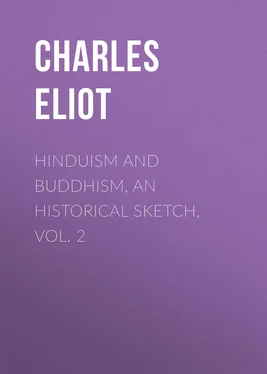Charles Eliot - Hinduism and Buddhism, An Historical Sketch, Vol. 2
Здесь есть возможность читать онлайн «Charles Eliot - Hinduism and Buddhism, An Historical Sketch, Vol. 2» — ознакомительный отрывок электронной книги совершенно бесплатно, а после прочтения отрывка купить полную версию. В некоторых случаях можно слушать аудио, скачать через торрент в формате fb2 и присутствует краткое содержание. Жанр: foreign_religion, Философия, Религиозная литература, foreign_psychology, foreign_antique, foreign_prose, на английском языке. Описание произведения, (предисловие) а так же отзывы посетителей доступны на портале библиотеки ЛибКат.
- Название:Hinduism and Buddhism, An Historical Sketch, Vol. 2
- Автор:
- Жанр:
- Год:неизвестен
- ISBN:нет данных
- Рейтинг книги:4 / 5. Голосов: 1
-
Избранное:Добавить в избранное
- Отзывы:
-
Ваша оценка:
- 80
- 1
- 2
- 3
- 4
- 5
Hinduism and Buddhism, An Historical Sketch, Vol. 2: краткое содержание, описание и аннотация
Предлагаем к чтению аннотацию, описание, краткое содержание или предисловие (зависит от того, что написал сам автор книги «Hinduism and Buddhism, An Historical Sketch, Vol. 2»). Если вы не нашли необходимую информацию о книге — напишите в комментариях, мы постараемся отыскать её.
Hinduism and Buddhism, An Historical Sketch, Vol. 2 — читать онлайн ознакомительный отрывок
Ниже представлен текст книги, разбитый по страницам. Система сохранения места последней прочитанной страницы, позволяет с удобством читать онлайн бесплатно книгу «Hinduism and Buddhism, An Historical Sketch, Vol. 2», без необходимости каждый раз заново искать на чём Вы остановились. Поставьте закладку, и сможете в любой момент перейти на страницу, на которой закончили чтение.
Интервал:
Закладка:
He is not a mere adaptation of any one Hindu god. Some of his attributes are also those of Brahmâ. Though in some late texts he is said to have evolved the world from himself, his characteristic function is not to create but, like Vishnu, to save and like Vishnu he holds a lotus. But also he has the title of Îśvara, which is specially applied to Śiva. Thus he does not issue from any local cult and has no single mythological pedigree but is the idea of divine compassion represented with such materials as the art and mythology of the day offered.
He is often accompanied by a female figure Târâ. 33 33 See especially de Blonay, Études pour servir à l'histoire de la déesse bouddhique Târâ , Paris, 1895. Târâ continued to be worshipped as a Hindu goddess after Buddhism had disappeared and several works were written in her honour. See Raj. Mitra, Search for Sk. MSS . IV. 168, 171, X. 67.
In the tantric period she is recognized as his spouse and her images, common in northern India from the seventh century onwards, show that she was adored as a female Bodhisattva. In Tibet Târâ is an important deity who assumes many forms and even before the tantric influence had become prominent she seems to have been associated with Avalokita. In the Dharmasangraha she is named as one of the four Devîs, and she is mentioned twice under the name of To-lo Pu-sa by Hsüan Chuang, who saw a statue of her in Vaisali and another at Tiladhaka in Magadha. This last stood on the right of a gigantic figure of Buddha, Avalokita being on his left. 34 34 About the time of Hsüan Chuang's travels Sarvajñâmitra wrote a hymn to Târâ which has been preserved and published by de Blonay, 1894.
Hsüan Chuang distinguishes To-lo (Târâ) and Kuan-tzǔ-tsai. The latter under the name of Kuan-yin or Kwannon has become the most popular goddess of China and Japan, but is apparently a form of Avalokita. The god in his desire to help mankind assumes many shapes and, among these, divine womanhood has by the suffrage of millions been judged the most appropriate. But Târâ was not originally the same as Kuan-yin, though the fact that she accompanies Avalokita and shares his attributes may have made it easier to think of him in female form. 35 35 Chinese Buddhists say Târâ and Kuan-Yin are the same but the difference between them is this. Târâ is an Indian and Lamaist goddess associated with Avalokita and in origin analogous to the Saktis of Tantrism. Kuan-yin is a female form of Avalokita who can assume all shapes. The original Kuan-yin was a male deity: male Kuan-yins are not unknown in China and are said to be the rule in Korea. But Târâ and Kuan-yin may justly be described as the same in so far as they are attempts to embody the idea of divine pity in a Madonna.
The circumstances in which Avalokita became a goddess are obscure. The Indian images of him are not feminine, although his sex is hardly noticed before the tantric period. He is not a male deity like Krishna, but a strong, bright spirit and like the Christian archangels above sexual distinctions. No female form of him is reported from Tibet and this confirms the idea that none was known in India, 36 36 But many scholars think that the formula Om manipadme hum, which is supposed to be addressed to Avalokita, is really an invocation to a form of Śakti called Maṇipadmâ. A Nepalese inscription says that "The Śâktas call him Śakti" ( E.R.E. vol. II. p. 260 and J.A. IX. 192), but this may be merely a way of saying that he is identical with the great gods of all sects.
and that the change was made in China. It was probably facilitated by the worship of Târâ and of Hâritî, an ogress who was converted by the Buddha and is frequently represented in her regenerate state caressing a child. She is mentioned by Hsüan Chuang and by I-Ching who adds that her image was already known in China. The Chinese also worshipped a native goddess called T'ien-hou or T'ou-mu. Kuan-yin was also identified with an ancient Chinese heroine called Miao-shên. 37 37 Harlez, Livre des esprits et des immortels , p. 195, and Doré, Recherches sur les superstitions en Chine , pp. 94-138.
This is parallel to the legend of Ti-tsang (Kshitigarbha) who, though a male Bodhisattva, was a virtuous maiden in two of his previous existences. Evidently Chinese religious sentiment required a Madonna and it is not unnatural if the god of mercy, who was reputed to assume many shapes and to give sons to the childless, came to be thought of chiefly in a feminine form. The artists of the T'ang dynasty usually represented Avalokita as a youth with a slight moustache and the evidence as to early female figures does not seem to me strong, 38 38 See Fenollosa, Epochs of Chinese and Japanese Art I. pp. 105 and 124; Johnston, Buddhist China , 275 ff. Several Chinese deities appear to be of uncertain or varying sex. Thus Chun-ti is sometimes described as a deified Chinese General and sometimes identified with the Indian goddess Marîcî. Yü-ti, generally masculine, is sometimes feminine. See Doré, l.c. 212. Still more strangely the Patriarch Aśvaghosha (Ma Ming) is represented by a female figure. On the other hand the monk Ta Shêng (c. 705 A.D.) is said to have been an incarnation of the female Kuan Yin. Mañjuśrî is said to be worshipped in Nepal sometimes as a male, sometimes as a female. See Bendall and Haraprasad, Nepalese MSS. p. lxvii.
though a priori I see no reason for doubting their existence. In 1102 a Chinese monk named P'u-ming published a romantic legend of Kuan-yin's earthly life which helped to popularize her worship. In this and many other cases the later developments of Buddhism are due to Chinese fancy and have no connection with Indian tradition.
Târâ is a goddess of north India, Nepal and the Lamaist Church and almost unknown in China and Japan. Her name means she who causes to cross, that is who saves, life and its troubles being by a common metaphor described as a sea. Târâ also means a star and in Puranic mythology is the name given to the mother of Buddha, the planet Mercury. Whether the name was first used by Buddhists or Brahmans is unknown, but after the seventh century there was a decided tendency to give Târâ the epithets bestowed on the Śaktis of Śiva and assimilate her to those goddesses. Thus in the list of her 108 names 39 39 de Blonay, l.c. pp. 48-57.
she is described among other more amiable attributes as terrible, furious, the slayer of evil beings, the destroyer, and Kâlî: also as carrying skulls and being the mother of the Vedas. Here we have if not the borrowing by Buddhists of a Śaiva deity, at least the grafting of Śaiva conceptions on a Bodhisattva.
The second great Bodhisattva Mañjuśrî 40 40 Chinese, Man-chu-shih-li, or Wên-shu; Japanese, Monju; Tibetan, hJam-pahi-dbyans (pronounced Jam-yang). Mañju is good Sanskrit, but it must be confessed that the name has a Central-Asian ring.
has other similar names, such as Mañjunâtha and Mañjughosha, the word Mañju meaning sweet or pleasant. He is also Vagîśvara, the Lord of Speech, and Kumârabhûta, the Prince, which possibly implies that he is the Buddha's eldest son, charged with the government under his direction. He has much the same literary history as Avalokita, not being mentioned in the Pali Canon nor in the earlier Sanskrit works such as the Lalita-vistara and Divyâvadâna. But his name occurs in the Sukhâvatî-vyûha: he is the principal interlocutor in the Lankâvatâra sûtra and is extolled in the Ratna-karaṇḍaka-vyûha-sûtra. 41 41 Translated into Chinese 270 A.D.
In the greater part of the Lotus he is the principal Bodhisattva and instructs Maitreya, because, though his youth is eternal, he has known many Buddhas through innumerable ages. The Lotus 42 42 Chaps. XI. and XIII.
also recounts how he visited the depths of the sea and converted the inhabitants thereof and how the Lord taught him what are the duties of a Bodhisattva after the Buddha has entered finally into Nirvana. As a rule he has no consort and appears as a male Athene, all intellect and chastity, but sometimes Lakshmî or Sarasvatî or both are described as his consorts. 43 43 A special work Mañjuśrîvikrîḍita (Nanjio, 184, 185) translated into Chinese 313 A.D. is quoted as describing Mañjuśrî's transformations and exploits.
Интервал:
Закладка:
Похожие книги на «Hinduism and Buddhism, An Historical Sketch, Vol. 2»
Представляем Вашему вниманию похожие книги на «Hinduism and Buddhism, An Historical Sketch, Vol. 2» списком для выбора. Мы отобрали схожую по названию и смыслу литературу в надежде предоставить читателям больше вариантов отыскать новые, интересные, ещё непрочитанные произведения.
Обсуждение, отзывы о книге «Hinduism and Buddhism, An Historical Sketch, Vol. 2» и просто собственные мнения читателей. Оставьте ваши комментарии, напишите, что Вы думаете о произведении, его смысле или главных героях. Укажите что конкретно понравилось, а что нет, и почему Вы так считаете.












